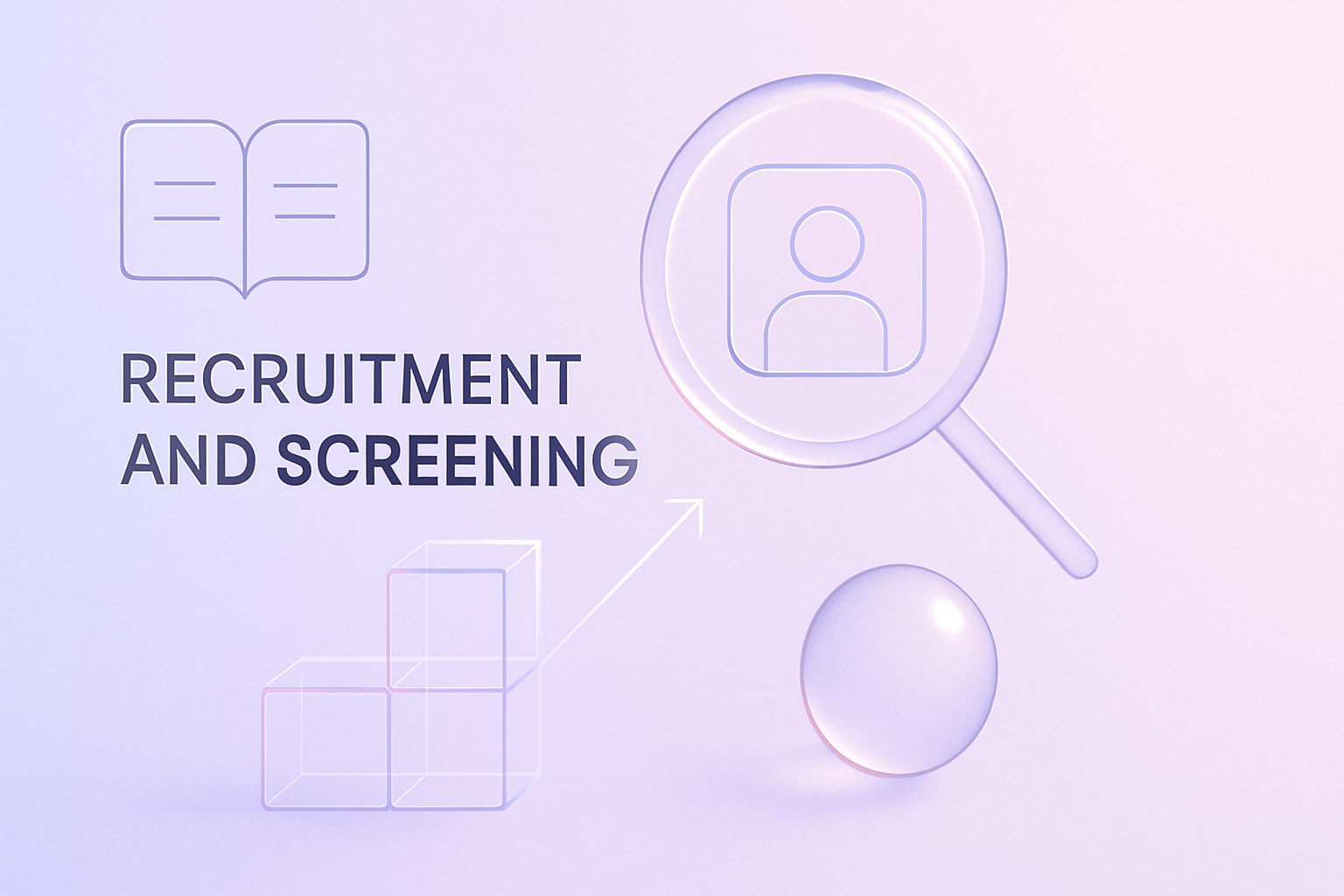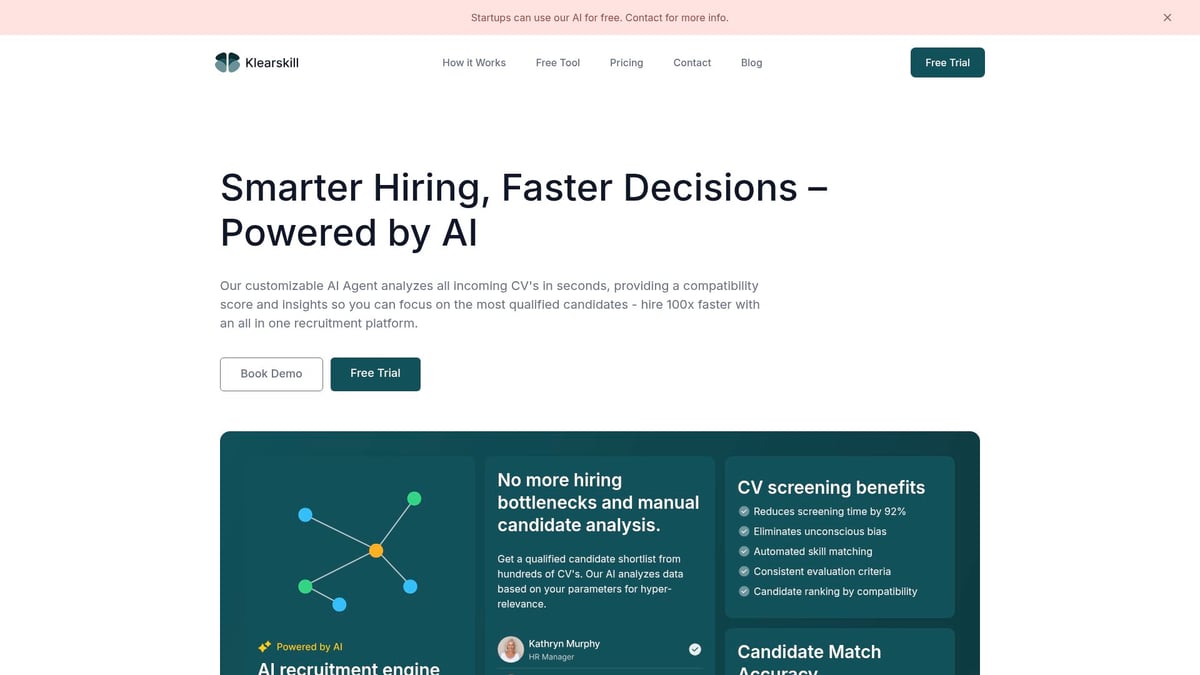October 8, 2025
Recruitment and Screening Guide for Effective Hiring 2025

In today’s rapidly shifting talent landscape, securing top candidates is both more challenging and more crucial than ever. The demands of the modern workforce, evolving technology, and rising competition mean organizations cannot afford missteps in their hiring processes.
This guide delivers a clear, actionable approach to recruitment and screening designed for 2025 and beyond. It equips HR professionals, recruiters, and business leaders with proven methods to streamline hiring, improve decision-making, and drive better business outcomes.
Explore the latest trends, step-by-step strategies, advanced screening techniques, and essential metrics to build a future-ready workforce. Ready to transform your hiring process? Let’s get started.
The Evolving Recruitment Landscape in 2025
The landscape for recruitment and screening is undergoing rapid change as we move into 2025. Organizations face new challenges and opportunities that require innovative approaches to finding, engaging, and hiring top talent. Understanding these evolving dynamics is essential for any HR professional aiming to build a future-ready workforce.

Shifting Candidate Expectations and Market Trends
Candidate expectations around recruitment and screening have shifted dramatically over the past year. The rise of remote and hybrid work models means flexibility is now a baseline requirement for many applicants. Companies that embrace flexible policies and showcase authentic employer branding are seeing significantly stronger talent pipelines. In fact, organizations offering flexible work options attract twice as many applicants as those that do not.
Diversity, equity, and inclusion have also become non-negotiable for top candidates. Over 70% of job seekers evaluate a company's values before applying, and a positive candidate experience is now a key differentiator. To stay ahead, HR leaders must monitor the latest data and insights, such as those highlighted in Top Recruitment Trends and Statistics for 2025, to ensure their recruitment and screening practices align with evolving market demands.
Technology and Automation in Recruitment
Technology is transforming every stage of recruitment and screening. AI-driven tools are now essential for sourcing and evaluating candidates at scale. Predictive analytics help organizations forecast talent needs, while digital assessment platforms make it possible to evaluate skills remotely and objectively.
Virtual interviewing has become the norm, enabling access to a wider talent pool regardless of location. Automation also reduces manual workload, allowing recruiters to focus on relationship-building and strategic decision-making. As a result, recruitment and screening processes are faster, more efficient, and less prone to human error.
Regulatory and Compliance Considerations
The regulatory landscape for recruitment and screening is more complex than ever. Updates to data privacy laws, such as GDPR, require companies to handle candidate information securely and transparently. New anti-bias regulations are influencing how organizations design their screening practices and adopt recruitment technology.
Recruiters must ensure that every step of the recruitment and screening process complies with current legal standards. This includes documenting procedures, training teams on compliance, and leveraging technology that supports privacy and fairness. These steps protect both candidates and employers while reinforcing trust in the hiring process.
Key Challenges for Modern Recruiters
Modern recruiters face a set of unique challenges in recruitment and screening. Talent shortages in specialized roles, rising costs per hire, and lengthening time-to-fill metrics are persistent issues. Managing large volumes of applicants without sacrificing quality or candidate experience adds another layer of complexity.
To overcome these challenges, organizations must adopt a strategic approach to recruitment and screening, balancing automation with personalized engagement. This ensures that only the most suitable candidates progress through the hiring funnel, improving outcomes for both employers and job seekers.
Opportunities for Competitive Advantage
Despite these challenges, there are significant opportunities for organizations willing to innovate in recruitment and screening. Leveraging a compelling employer value proposition (EVP) helps attract high-quality candidates. Personalizing candidate engagement at scale, through targeted communications and tailored assessments, increases satisfaction and conversion rates.
Building agile recruitment teams that can adapt quickly to market changes is also crucial. By focusing on continuous improvement and embracing new technologies, companies can create a recruitment and screening process that delivers long-term competitive advantage.
Step 1: Workforce Planning and Job Analysis
Effective recruitment and screening start with thorough workforce planning and job analysis. Before sourcing candidates, organizations need clarity on what roles are truly needed and what skills will drive business success. Taking a strategic approach at this stage ensures every step of recruitment and screening aligns with broader organizational objectives.

Defining Business Needs and Role Requirements
Start by aligning recruitment and screening with your organization's mission and growth plans. Collaborate with department heads to forecast workforce needs and identify skill gaps. Ask: What roles are critical for upcoming projects? Are there emerging technologies or markets that require new expertise?
- Review current team strengths and weaknesses.
- Analyze upcoming business initiatives for talent demands.
- Prioritize roles that directly impact strategic goals.
Using data-driven insights at this stage ensures recruitment and screening focus on the right roles, reducing wasted effort and cost.
Crafting Accurate and Inclusive Job Descriptions
A well-crafted job description is the foundation of effective recruitment and screening. Use clear, bias-free language to attract a diverse candidate pool. Outline responsibilities, must-have skills, and future growth opportunities. Inclusive job ads attract 30% more qualified applicants, ensuring your pipeline is both broad and deep.
- Write job titles that reflect actual duties.
- Detail essential and desirable qualifications.
- Highlight your organization's values and culture.
For more insights on optimizing job descriptions and screening, see Recruitment Screening Best Practices.
Stakeholder Collaboration
Involve hiring managers and team leads early to clarify expectations and set realistic timelines. This proactive engagement helps align recruitment and screening with operational needs and reduces miscommunication.
- Schedule kickoff meetings to discuss role requirements.
- Agree on evaluation criteria and interview stages.
- Establish clear communication channels for updates.
Collaboration ensures everyone is invested in the process and contributes to a smoother candidate journey.
Forecasting and Budgeting for Recruitment
Anticipate future hiring by analyzing projected attrition, business expansion, and market trends. Allocate budgets for sourcing, advertising, and technology to support effective recruitment and screening.
- Use historical data to estimate headcount needs.
- Identify seasonal or project-based hiring spikes.
- Plan for technology investments that streamline processes.
Accurate forecasting ensures your talent acquisition strategy remains agile and cost-effective.
Compliance and Documentation
Ensure every step of recruitment and screening complies with legal and regulatory standards. Document job requirements and decisions for transparency and future audits.
- Use standardized templates for job descriptions.
- Maintain records of stakeholder input and approvals.
- Stay updated on changes to employment laws and industry regulations.
A robust compliance process protects your organization and builds trust with candidates.
Step 2: Sourcing Strategies for Top Talent
Attracting top talent in today’s market requires a deliberate, multi-faceted approach. The recruitment and screening process must begin with targeted sourcing strategies that reach candidates wherever they are. Organizations that adapt quickly to market shifts, leverage technology, and prioritize diversity will build stronger pipelines and future-ready teams.

Building a Multi-Channel Sourcing Plan
A successful recruitment and screening strategy starts with a robust sourcing plan that maximizes reach. Companies should tap into multiple channels to access diverse talent pools, including:
- Leading job boards and niche platforms
- Social media networks like LinkedIn and Twitter
- Employee referral programs
- Internal talent pools and alumni networks
Research shows organizations using LinkedIn Recruiter see sourcing speeds increase by 50%. To stay competitive, review current channels regularly and invest in those that deliver the best results. For more on evolving sourcing trends and future-ready strategies, see the 2025 Talent Trends Report.
Employer Branding and Talent Attraction
Employer branding is central to recruitment and screening success. Candidates today research company reputation and culture before applying. A strong employer brand—showcased through engaging career pages, authentic social media content, and transparent leadership—attracts higher-quality applicants.
Highlight organizational values, DEI initiatives, and employee testimonials. According to industry data, 75% of candidates consider employer reputation an essential factor. By investing in your brand, you enhance both sourcing efficiency and candidate quality.
Proactive Talent Pipelining
Building talent pipelines is a proactive way to ensure a steady flow of qualified candidates for critical roles. Recruitment and screening benefit from engaging passive candidates through:
- Talent communities and regular newsletters
- Virtual events, webinars, and hackathons
- Direct outreach for in-demand skill sets
Talent pipelining shortens time-to-fill and reduces hiring costs. By nurturing relationships with top talent, companies can respond quickly to future hiring needs and maintain a competitive edge.
Diversity Sourcing Initiatives
Diversity, equity, and inclusion are vital in recruitment and screening. Expand outreach by partnering with organizations that support underrepresented groups. Participate in industry events, sponsor educational programs, and tailor job advertisements to appeal to diverse audiences.
Implement structured sourcing processes that minimize bias and promote fair consideration. Diverse teams drive innovation, improve performance, and reflect your customer base more accurately.
Metrics and Optimization
Continuous improvement is essential for recruitment and screening excellence. Track key sourcing metrics such as:
| Metric | Purpose |
|---|---|
| Source-of-hire | Identify most effective channels |
| Cost-per-source | Optimize budget allocation |
| Conversion rates | Measure candidate movement in funnel |
Regularly analyze results to refine your sourcing strategy. Use performance data to make informed decisions, reallocate resources, and strengthen your recruitment and screening outcomes.
Step 3: Screening and Shortlisting Candidates
Finding the right talent in a crowded market requires a rigorous recruitment and screening process. Each stage, from resume review to compliance checks, plays a vital role in narrowing your candidate pool to the most qualified individuals. Below, we break down best practices and advanced techniques you need to master for success in 2025.
Resume Screening Best Practices
Resume screening is the first gateway in recruitment and screening. Establishing clear, objective criteria ensures you evaluate all candidates fairly. Define the core skills, experience, and qualifications required for the role before reviewing any applications.
- Use structured scoring rubrics to reduce bias
- Focus on quantifiable achievements and relevant experience
- Disregard personal information that could introduce unconscious bias
Organizations using standardized rubrics for recruitment and screening report a 40% reduction in screening errors. Consistent evaluation also helps in building a robust candidate pipeline.
Leveraging Technology for Efficient Screening
Modern recruitment and screening relies on technology to manage high application volumes. AI-powered platforms automate resume parsing and candidate ranking, saving valuable time. These tools compare resumes against job requirements and highlight top matches instantly.
For a deeper dive into how automation streamlines the process, see Automated Resume Screening Software.
- AI reduces manual screening time by up to 92%
- Automated systems flag skills gaps and keyword matches
- Integration with ATS ensures a seamless workflow
By integrating technology, recruitment and screening becomes more efficient and scalable, allowing teams to focus on high-value tasks.
How AI Recruitment Software Transforms Screening
AI recruitment software has revolutionized recruitment and screening. These platforms analyze CVs, rank candidates by customizable parameters, and generate shortlists in moments. By focusing on skills and experience, AI eliminates unconscious bias and enhances decision-making.

- Delivers 97% match accuracy for technical roles
- Integrates with existing systems for unified workflows
- Supports compliance by anonymizing sensitive data
Recruiters using AI tools consistently report faster, more accurate results in recruitment and screening, especially for technical positions.
Assessments and Pre-Employment Testing
Assessments are a cornerstone of effective recruitment and screening. Incorporate skills tests, cognitive assessments, and personality profiles to evaluate candidates beyond their resumes. All tests should be validated, fair, and directly relevant to job requirements.
- Skills assessments measure technical proficiency
- Cognitive tests evaluate problem-solving and learning agility
- Personality profiles reveal cultural fit and teamwork potential
Companies leveraging pre-employment assessments in recruitment and screening see a 24% improvement in quality-of-hire, ensuring only the best candidates progress.
Structured Phone and Video Screening
Phone and video interviews are essential for remote recruitment and screening. Standardize your questions and use consistent scoring to compare candidates objectively. Video platforms enable you to reach global talent, streamlining the early interview stages.
- Prepare a question bank for consistency
- Use video recordings for later review and calibration
- Provide clear instructions and timelines to candidates
Structured interviews increase predictive validity by 62%, making recruitment and screening more reliable and fair.
Ensuring Compliance and Data Privacy
Compliance is crucial in every recruitment and screening process. Secure candidate data handling and adherence to anti-discrimination laws are non-negotiable. Stay updated on evolving regulations such as GDPR or local privacy frameworks.
- Store candidate data securely and limit access
- Use anonymized data during initial screening rounds
- Document all screening decisions for transparency
Protecting candidate privacy not only reduces legal risk but also demonstrates your company's commitment to ethical recruitment and screening practices.
Step 4: Effective Interviewing and Candidate Evaluation
Conducting effective interviews is the linchpin of successful recruitment and screening. With the right approach, organizations can identify top talent, reduce biases, and ensure every hire aligns with business goals. This stage transforms candidate assessments into actionable insights for confident decision-making.
Designing a Structured Interview Process
A structured interview process is essential for fair and consistent recruitment and screening. Clearly define each interview stage, such as HR screening, technical assessments, and panel interviews. Use behavioral and situational questions to gauge how candidates handle real-life scenarios.
One effective method is the STAR technique (Situation, Task, Action, Result), which ensures every candidate is evaluated on the same criteria. This approach allows interviewers to compare responses objectively. Structuring the process minimizes variability, making recruitment and screening outcomes more reliable.
A simple table can help organize interview stages:
| Stage | Purpose | Example Questions |
|---|---|---|
| HR Screening | Cultural fit, basics | Why our company? |
| Technical Interview | Skills assessment | Describe a recent project. |
| Panel Interview | Team compatibility | How do you handle conflict? |
By mapping out interviews, teams create a repeatable process that supports effective recruitment and screening.
Interviewer Training and Calibration
Training interviewers is crucial for unbiased recruitment and screening. All interviewers should understand legal compliance, anti-discrimination guidelines, and the importance of structured questioning. Regular calibration meetings align scoring standards across the team.
Use mock interviews and feedback sessions to reinforce best practices. Discuss common pitfalls, such as leading questions or unconscious bias, to strengthen interviewer confidence. Calibration ensures that every candidate receives a consistent experience during recruitment and screening.
Encourage interviewers to review past decisions and scoring patterns. This reflection helps identify areas for improvement, supporting continuous growth in recruitment and screening expertise.
Candidate Experience During Interviews
A positive candidate experience is a competitive advantage in recruitment and screening. Communicate the process and timelines clearly from the start. Transparency helps candidates feel respected and informed.
Offer timely feedback and maintain engagement through every stage. Even candidates who are not selected should leave with a favorable impression. Data shows that companies with strong candidate experiences see a 38 percent increase in offer acceptance rates.
Consider using video interviews for remote applicants and provide resources to help them prepare. These steps demonstrate your commitment to a fair and inclusive recruitment and screening process.
Collaborative Evaluation and Decision-Making
Collaborative evaluation is key to robust recruitment and screening. Use scorecards to capture interviewer feedback objectively, then hold consensus meetings to discuss findings. Involving multiple stakeholders leads to well-rounded hiring decisions.
For further insight on evaluation methods, explore Shortlisting Candidates Techniques, which covers structured approaches to narrowing down the best applicants. This ensures your recruitment and screening process remains efficient and unbiased.
Encourage open discussion during decision meetings. A diverse panel can challenge assumptions and reduce the risk of hiring mistakes, making recruitment and screening more effective.
Reference and Background Checks
Reference and background checks are the final safeguards in recruitment and screening. Verify employment history, credentials, and professional references to confirm candidate claims.
Ensure all checks comply with legal standards and privacy regulations. Use standardized templates for reference questions to maintain consistency. Document findings in your applicant tracking system for future audits.
By closing the loop with thorough verification, you protect your organization and uphold the integrity of your recruitment and screening process.
Step 5: Making the Offer and Onboarding
Securing top talent does not end once you have identified the ideal candidate through recruitment and screening. The final step, making the offer and onboarding, is crucial for converting candidates into engaged employees and setting the stage for long-term retention.
Crafting Competitive Offers
An effective recruitment and screening process culminates in a compelling offer. Benchmark compensation and benefits using market data to ensure competitiveness.
Personalize offers by considering the candidate’s motivations, such as remote work options, flexible hours, or professional development opportunities. Flexibility in benefits can significantly boost offer acceptance rates.
Use a table to summarize elements of a strong offer:
| Offer Element | Description |
|---|---|
| Salary & Bonus | Competitive, role-aligned |
| Benefits | Health, wellness, retirement |
| Flexibility | Remote/hybrid options, flex hours |
| Growth Opportunities | Training, career progression |
A tailored approach demonstrates your organization’s commitment to meeting individual needs.
Offer Communication and Negotiation
Clear, prompt communication is essential when extending offers. Share all details, including compensation, benefits, and role expectations, in writing.
Be prepared for negotiations. Approach discussions with empathy, transparency, and a collaborative mindset. This builds trust and increases the likelihood of acceptance.
According to Recruitment Statistics for 2025, organizations that respond quickly and engage in open negotiation see higher acceptance rates, which underscores the importance of a streamlined recruitment and screening process.
Pre-Boarding Engagement
Once the candidate accepts, keep them engaged before their start date. Effective pre-boarding bridges the gap between offer acceptance and the first day, reducing the risk of drop-off.
Share onboarding materials, company information, and introduce them to their team or assigned mentor. This step reinforces the positive experience established during recruitment and screening, building anticipation and connection.
Regular check-ins and answering questions early help new hires feel valued, smoothing their transition into the organization.
Structured Onboarding Programs
A structured onboarding program sets clear expectations and accelerates productivity. Design onboarding plans that cover both role-specific training and cultural integration.
Set 30-60-90 day goals, provide access to necessary tools, and schedule regular feedback sessions. Assigning onboarding buddies or mentors fosters belonging and support.
Research from the Latest HR & Talent Statistics (2025) highlights that effective onboarding programs can increase new hire retention by over 80 percent. This demonstrates the direct link between recruitment and screening outcomes and long-term organizational success.
Feedback and Continuous Improvement
Gather feedback from new hires about their offer and onboarding experience. Use surveys, interviews, or informal check-ins to identify strengths and areas for improvement.
Iterate on your recruitment and screening, offer, and onboarding processes based on this feedback. Continuous improvement ensures your approach remains competitive and responsive to evolving talent expectations.
A culture of open feedback not only strengthens your recruitment and screening framework, but also enhances employee engagement and retention.
Key Metrics and Continuous Optimization of Hiring
In today's dynamic talent market, tracking the right metrics is essential for optimizing recruitment and screening outcomes. Data-driven hiring is now fundamental for organizations aiming to attract, assess, and retain top talent. By continuously monitoring performance, teams can refine strategies and drive better hiring results. Let’s explore the critical metrics and strategies that will shape recruitment and screening success in 2025.
Essential Recruitment Metrics to Track
Measuring the right data points is the backbone of effective recruitment and screening. Core metrics include time-to-fill, cost-per-hire, quality-of-hire, and candidate satisfaction scores.
| Metric | Why It Matters | Example Impact |
|---|---|---|
| Time-to-fill | Measures hiring efficiency | Shorter time boosts productivity |
| Cost-per-hire | Tracks resource allocation | Reduces overall HR spend |
| Quality-of-hire | Assesses new hire performance | Improves retention by 20% |
| Candidate satisfaction | Evaluates process experience | Increases offer acceptance rates |
Understanding these measurements, and their impact, is crucial. For foundational knowledge on assessments and compliance, see Pre-Employment Screening Explained.
Leveraging Analytics for Process Improvement
Analytics transform recruitment and screening from guesswork into a precise science. By evaluating funnel conversion rates and identifying bottlenecks, hiring teams can pinpoint inefficiencies and act quickly.
Regularly reviewing sourcing and screening data helps organizations refine their approach. For instance, tracking the ratio of candidates moving from application to interview reveals which stages need attention. Using analytics ensures decisions are informed, leading to smarter, faster, and more cost-effective hires.
Candidate Experience Measurement
A positive candidate experience is now a competitive differentiator in recruitment and screening. Implementing candidate Net Promoter Score (NPS) surveys provides direct feedback on what works and what needs improvement.
Short, targeted surveys at each step help capture meaningful insights. Teams can then adjust communication, timelines, and touchpoints to enhance satisfaction. An improved experience not only boosts employer brand but also increases the likelihood that top candidates accept offers and refer others.
Benchmarking and Industry Comparison
Benchmarking recruitment and screening metrics against industry standards highlights where your process excels and where there’s room for growth. By comparing time-to-fill or quality-of-hire data to similar organizations, HR teams can set realistic targets and justify investments.
Industry benchmarking also uncovers emerging trends and best practices. This ongoing process keeps your recruitment and screening strategy current and competitive, supporting continuous improvement and agility.
Building a Culture of Data-Driven Hiring
For recruitment and screening optimization to succeed, organizations must foster a culture of data-driven decision-making. This involves training hiring teams to interpret analytics, setting clear KPIs, and regularly reviewing performance.
Encouraging open discussion about metrics and results drives accountability and innovation. When data becomes part of daily practice, recruitment and screening processes evolve, ensuring that hiring strategies remain effective as the market changes.
Adapting to Future Trends
Continuous learning is vital for staying ahead in recruitment and screening. Teams should regularly update their knowledge on new technologies, regulatory changes, and market shifts.
Investing in upskilling and agile practices helps organizations respond quickly to evolving talent needs. By making data, feedback, and adaptability central to recruitment and screening, companies build a resilient hiring process ready for future challenges.
